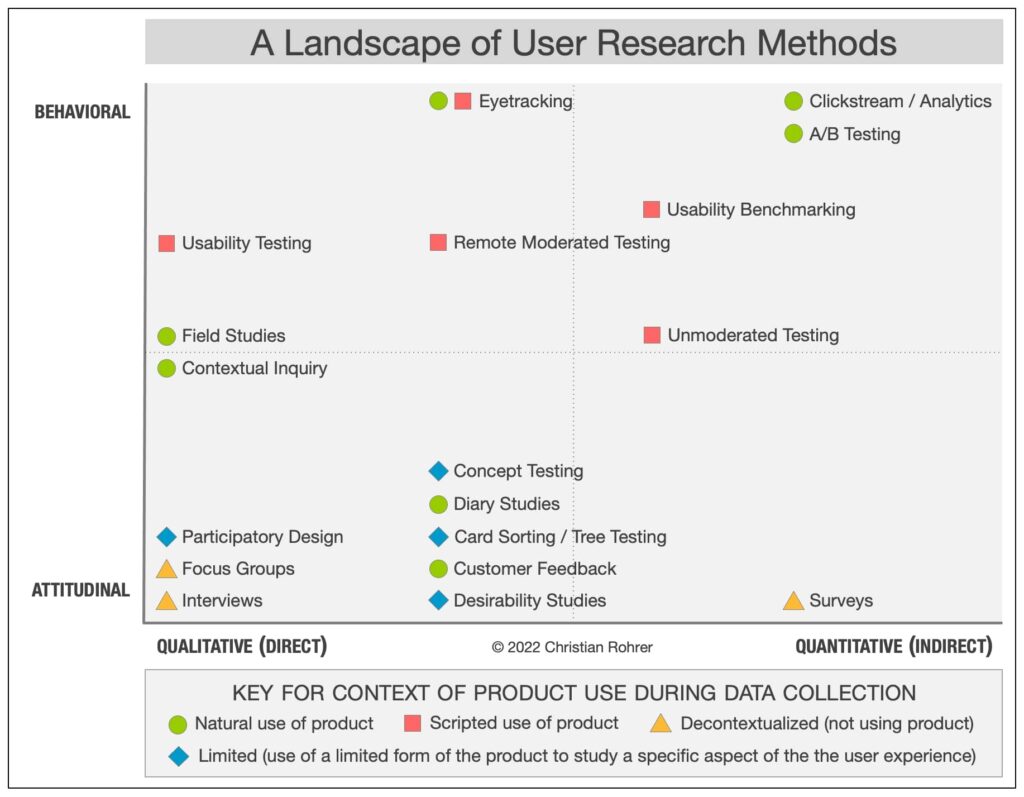Introduction
The R&E Search for Evidence blog started more than seven years ago and currently features 240 posts by 143 FHI 360 staff authors (current and former), covering a wide range of topics across all practice areas at FHI 360. Together, the posts have generated 312,639 page views by 194,322 readers. The blog’s goals are to communicate evidence in a non-academic way, position FHI 360 as a thought leader, and provide professional development opportunities for staff at all levels within the organization.
Methods
The research uses a combination of behavioral, attitudinal, qualitative, and quantitative methods (See Figure 1).
Evaluation framework and indicators
To evaluate the goals of the blog, we identified seven metrics with seventeen corresponding indicators. The seven metrics are: the audience; user acquisition channels; points of user drop-off or departure; opportunities for greater user acquisition; pathways for deeper and more rewarding user engagement; the blog’s representation of FHI 360’s reputation as a research organization; and how the blog creates a channel for staff to be externally promoted.
Table 1 shows these metrics and the corresponding indicators, as well as the data source for each indicator.
| Metric | Indicators | Source |
|---|---|---|
| Audience | 1. User demographics: age, gender, location 2. Default browser language 3. Device type | Google analytics |
| Describe user acquisition and departure from the blog | ||
| User acquisition channels | 1. User source by type 2. Social media post traffic / click-rate | Google analytics Social media analytics |
| Points of user drop-off or departure | user departure / exit page | Google analytics |
| Opportunities for greater user acquisition | 1. User acquisition and departure 2. Social media traffic | Google analytics |
| Pathways for deeper and more rewarding user engagement | 1. User acquisition and departure 2. Time on site / time per session 3. Site search terms 4. Share rates to social | Google analytics Social media search In-page survey |
| Understand how well the blog achieves its strategic goals | ||
| The blog’s representation of FHI 360's reputation as a research organization | 1. User sentiment analysis 2. Comparison of this blog with blogs from peer organizations | In-page survey Comparative analysis |
| How the blog creates a channel for staff to be externally promoted | 1. Staff knowledge of the blog 2. Staff desire to contribute to blog 3. Reflections of staff who have contributed blog posts | Author survey Focus group of repeat authors Traffic to author’s social media or websites (google analytics) |
Key findings
We learned multiple cross-cutting themes about the value of blogs in communicating research.
Blogs are a critically important tool for communicating research
Across all streams of data collection, it is clear that blogs such as R&E Search for Evidence serve a unique purpose in communicating evidence, one that is unique from publications or other academic fora. Traffic to the R&E search for evidence blog is heaviest to technical or methods-focused pages. The five most popular posts are:
- Riddle me this: How many interviews (or focus groups) are enough?
- How to conduct a replication study: What not to do
- Why should practitioners publish their research in journals?
- What disability screening tools are available to use in low-resource schools?
- 5 features of a monitoring, evaluation and learning system geared towards equity in education
Technical blogs are not unique to FHI 360, either. In analyzing peers in the development sector, we find that most large NGOs and funders have some type of technical blog to communicate science and research. Forums like ABT Global’s “Perspectives”, the Evidence for action “Methods” blog, or 3ie’s “Evidence Matters” are all examples of development experts trying to communicate technical research in more accessible ways. The R&E Search for Evidence blog is similar to peers’ blogs in content, frequency of posts, and communication strategy.
Blogs are an opportunity for early-career professionals to establish their public scientific presence
A survey of authors published on the R&E Search for Evidence blog reveals that 76% of authors used their post for disseminating their work – sharing the post via social media, promoting it to peers and colleagues, and adding it to their resume and LinkedIn profiles. Moreover, 20% of the authors used their blog posts for securing speaking engagements, strengthening job applications, and seeking promotions at work.
Authors noted a tension between a highly rigorous process and the speed and informality of publishing blog posts. Focus group respondents also noted that more promotional blogs, project-specific blogs, or opinion-based blogs are faster and easier to publish on, but do not bring as much value to researchers. However, blogs with a high level of rigor and specific focus on communicating research and evidence bring higher recognition and value to the authors but take more time and effort.
Blogs are a valuable tool for NGOs and organizational communications
Lastly, blogs offer a channel for organizations to articulate evidence-based opinions on key issues. By running a technical blog, an organization can synthesize knowledge from their experience, promote a specific practice or approach, and share knowledge with their broader community.
Limitations and ongoing research
This research is limited to qualitative and active feedback from authors; we are still gathering feedback from end-users of the blog, readers like yourself. Surveys on the blog (you may have noticed that bar at the bottom, or box at the end of this post – thank you for your response) aim to solicit more active feedback from readers on their “jobs to be done” and satisfaction with the experience. We have also sent out a survey to subscribers but received minimal responses. This ongoing research will allow us to adapt the blog to users’ needs and expectations.
Conclusions
The research clearly shows that blogs also provide an opportunity for early-career professionals, giving a chance for them to express their voice, demonstrate their knowledge on a topic, and begin to create their online presence and digital reputation. This is useful when pursuing career opportunities, seeking funding, or networking.
For organizations that rely on project-based funding, we recommend that proposals and project planning should include resources dedicated to blogs and other thought-leadership pieces; this should not be an afterthought or “nice to have,” but a critical communication and professional development tool. Funders can also suggest or require non-academic forums for research communications to further incentivize this type of work.
Nearly eight years since R&E Search for Evidence was established, we are confident saying that it is a critical tool in research communications and organizational thought-leadership. We at FHI 360 do not want to be unique in this; we hope to see continued and increased use of technical blogs for knowledge sharing and evidence promotion in the development community. These blogs are critical not only for sharing best practices and emerging research, but also for developing professionals in establishing their careers. Lastly, thank you to our readers for your continued engagement and readership, and we hope to keep this content coming.





